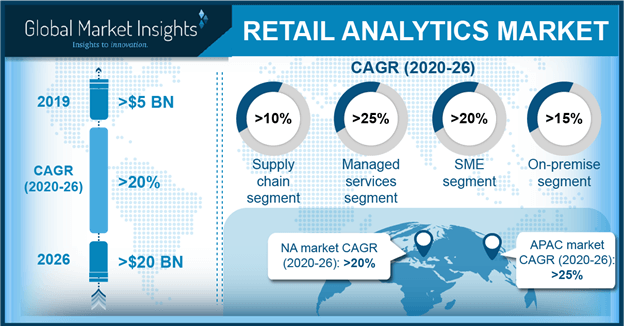Top 2 trends prevalent in retail analytics market: Harnessing IoT and big data to revolutionize the retail fraternity
One of the latest trends proliferating retail analytics market is that of multiple operational channels. Or, as the experts say so – omni-channels. The technique has brought about a modest amount of consolidation in retail analytics industry, surreptitiously eliminating supply chain chaos and location glitches. While global markets have been attempting to emulate high-grade technology and big data analytics, the retail sector has quietly been engaging with omni-channels to entice more customers, keep them continually engaged, draw data from a stream of sources, and bring about extensive social engagement to trigger a better understanding among consumers regarding the distribution chain. This initiative fosters the deployment of efficient analytics, which will ultimately usher in a new dawn for retail analytics market. The extensive reach of the retail business, in conjunction with the steadfastly developing e-commerce sector, is also certain to act as a catalyst to Retail Analytics Market, which, as per experts, is forecast to cross a valuation of USD 13 billion by 2024.
U.S. Retail Analytics Market Size, By Function, 2016 & 2024 ($Mn)

Retail analytics is essentially the process of delivering critical insights about a myriad range of retail verticals such as supply chain models, distribution chain, inventory levels, sales, and consumer demand, that form the crux of making crucial decisions, In a nutshell, retail analytics industry encompasses an enormous scope, given the fact that the deployment of data analytics in the retail market gives companies an inherent overview of business, processes, and customer insights, thereby opening up the channels for improvement and progress. IBM’s recent partnership with SAP for jointly developing data solutions for the retail sphere is an instance of how companies have been forging partnerships to lead retail analytics market on the path of progress.
Top trends underlining retail analytics market:
Cross-platform analytics
With the retail space spread across numerous distribution channels, the onus is on big data analytics solutions to track data as minutely as possible. Consumers may use one or more channels to view a product and make an informed choice. Analytic solutions need to able to penetrate this barrier and unearth the audiences through all these platforms in order that retail giants are able to provide a seamless shopping experience.
The extensive demand for real-time data to be communicated across the value chain – sales staff, consumers, distributors, and the like will thus, prompt retail analytics market players to come up with a range of effective solutions. Lately, the proliferation of technology has led to the massive deployment of both on-premise and cloud-based solutions, which will eventually result in the development of retail analytics market.
Get a Sample Copy of this Report@ https://www.gminsights.com/request-sample/detail/319
The proliferation of IoT
IoT is the latest incantation being followed by major giants partaking in retail analytics industry share. With the retail sector, consumer is king, and high-grade consumer experience can only be obtained via the deployment of IoT and augmented reality. The former in fact, is nearly on the verge of encapsulating retail analytics market. If estimates are to be believed, retailers may spend more than USD 2 billion on IoT-enabled devices by 2020. Furthermore, more than 65% retailers will depict an earnestness to integrate connected devices in their business models – a fact which may transform the face of retail analytics market.
The deployment of IoT has a plethora of benefits to offer, right from efficient data collection, consumer movement monitoring, real-time supply and demand analysis, and so on. Considering the vast expanse of the retail sector and the intense competitive aura that permeates this space, it is certain that the adoption of connected technology will augment retail analytics market.
An inherent shift of dynamics has been observed in the deployment of predictive analytics lately. This type of analytics basically entails guesswork regarding consumer behavior and choices and has proved to be fairly successful in retail analytics industry, in the initial years of inception. With the passage of time however, the need for a more efficient, practiced methodology arose in retail analytics market, which resulted in the genesis of an explanatory business model. This type of analytics gives an extended explanation of data – inventory requirement, store requirements, consumer demand, and product trends -in other words, this type of analytics identifies trends that may have a sizable impact, which is a godsend in retail analytics market.
What can be deduced from this transformative trend is that the retail sector has been on the lookout for novel technologies to forge a connection with consumers. In order to be a part of this ever-changing spectrum, it is essential for retailers to bring about a change in their outlook to create value. This modified school of thought is certain to usher in a unique speculation of sorts for retail analytics market giants, who have been bending over backwards to codify a new set of advanced solutions for the retail sector. Inadvertently, it is expected that their efforts will bear fruit, and retail analytics market will establish new frontiers of growth in the years ahead.
Author Name : Saipriya Iyer
